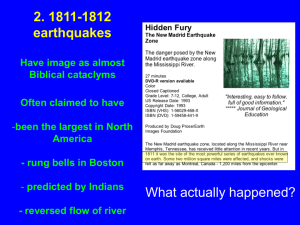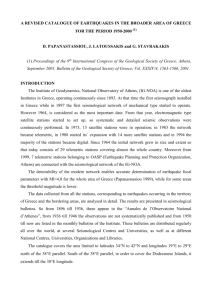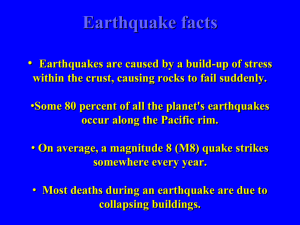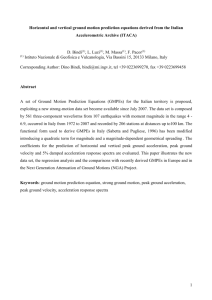Revised magnitudes of relocated Italian earthquakes catalogue
advertisement
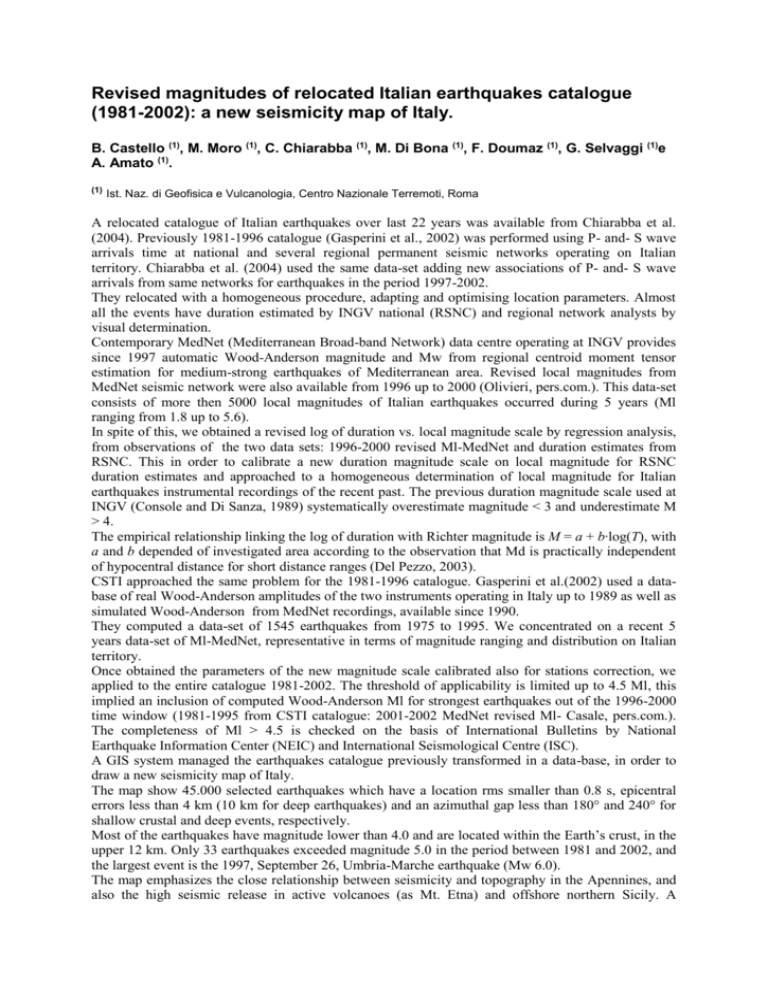
Revised magnitudes of relocated Italian earthquakes catalogue (1981-2002): a new seismicity map of Italy. B. Castello (1), M. Moro (1), C. Chiarabba (1), M. Di Bona (1), F. Doumaz (1), G. Selvaggi (1)e A. Amato (1). (1) Ist. Naz. di Geofisica e Vulcanologia, Centro Nazionale Terremoti, Roma A relocated catalogue of Italian earthquakes over last 22 years was available from Chiarabba et al. (2004). Previously 1981-1996 catalogue (Gasperini et al., 2002) was performed using P- and- S wave arrivals time at national and several regional permanent seismic networks operating on Italian territory. Chiarabba et al. (2004) used the same data-set adding new associations of P- and- S wave arrivals from same networks for earthquakes in the period 1997-2002. They relocated with a homogeneous procedure, adapting and optimising location parameters. Almost all the events have duration estimated by INGV national (RSNC) and regional network analysts by visual determination. Contemporary MedNet (Mediterranean Broad-band Network) data centre operating at INGV provides since 1997 automatic Wood-Anderson magnitude and Mw from regional centroid moment tensor estimation for medium-strong earthquakes of Mediterranean area. Revised local magnitudes from MedNet seismic network were also available from 1996 up to 2000 (Olivieri, pers.com.). This data-set consists of more then 5000 local magnitudes of Italian earthquakes occurred during 5 years (Ml ranging from 1.8 up to 5.6). In spite of this, we obtained a revised log of duration vs. local magnitude scale by regression analysis, from observations of the two data sets: 1996-2000 revised Ml-MedNet and duration estimates from RSNC. This in order to calibrate a new duration magnitude scale on local magnitude for RSNC duration estimates and approached to a homogeneous determination of local magnitude for Italian earthquakes instrumental recordings of the recent past. The previous duration magnitude scale used at INGV (Console and Di Sanza, 1989) systematically overestimate magnitude < 3 and underestimate M > 4. The empirical relationship linking the log of duration with Richter magnitude is M = a + b∙log(T), with a and b depended of investigated area according to the observation that Md is practically independent of hypocentral distance for short distance ranges (Del Pezzo, 2003). CSTI approached the same problem for the 1981-1996 catalogue. Gasperini et al.(2002) used a database of real Wood-Anderson amplitudes of the two instruments operating in Italy up to 1989 as well as simulated Wood-Anderson from MedNet recordings, available since 1990. They computed a data-set of 1545 earthquakes from 1975 to 1995. We concentrated on a recent 5 years data-set of Ml-MedNet, representative in terms of magnitude ranging and distribution on Italian territory. Once obtained the parameters of the new magnitude scale calibrated also for stations correction, we applied to the entire catalogue 1981-2002. The threshold of applicability is limited up to 4.5 Ml, this implied an inclusion of computed Wood-Anderson Ml for strongest earthquakes out of the 1996-2000 time window (1981-1995 from CSTI catalogue: 2001-2002 MedNet revised Ml- Casale, pers.com.). The completeness of Ml > 4.5 is checked on the basis of International Bulletins by National Earthquake Information Center (NEIC) and International Seismological Centre (ISC). A GIS system managed the earthquakes catalogue previously transformed in a data-base, in order to draw a new seismicity map of Italy. The map show 45.000 selected earthquakes which have a location rms smaller than 0.8 s, epicentral errors less than 4 km (10 km for deep earthquakes) and an azimuthal gap less than 180° and 240° for shallow crustal and deep events, respectively. Most of the earthquakes have magnitude lower than 4.0 and are located within the Earth’s crust, in the upper 12 km. Only 33 earthquakes exceeded magnitude 5.0 in the period between 1981 and 2002, and the largest event is the 1997, September 26, Umbria-Marche earthquake (Mw 6.0). The map emphasizes the close relationship between seismicity and topography in the Apennines, and also the high seismic release in active volcanoes (as Mt. Etna) and offshore northern Sicily. A concentration of subcrustal and deep earthquakes is evident in the Southern Tyrrhenian sea, where the Ionian lithosphere subducts beneath the Calabrian arc. The largest deep earthquakes in the period occurred on 1994, January 6th in the Southern Tyrrhenian Sea, with a moment magnitude (Mw) of 5.8, at 200 km depth. Acknowledgements We thank all the INGV people who continuously analyze data from the National Seismic Network We also thank the University of Genova, INOGS Trieste, the University of Calabria, the University of Bari, IGT of Prato, ENI-AGIP, O.B. of Perugia, Regione Marche, the University of L’Aquila, Servizio Sismico Nazionale (SSN), INGV-OV, INGV-CT and, which provided arrival time data. The development and maintenance of the National Seismic Network is carried out by the National Earthquake Centre of INGV with the support of the National Department of Civil Protection. References Chiarabba C., Jovane L, and Di Stefano R.; 2004; A new global view of Italian seismicity using 20 years of instrumental recordings. Tectonophysics, in press Gasperini P.;2002; Local magnitude revaluation for recent Italian earthquakes (1981-1996). Journal of Seismology, 6, 503524. Console R., De Simoni B., and Di Sanza A.;1989; Riesame della relazione magnitudo-durata. Proceedings of the VII Conference of the Gruppo Nazionale di Geofisica della Terra Solida (GNGTS), Rome, Novembre 30-December 2 1988, 5161. Del Pezzo E., Bianco F. and Saccarotti G.; 2003; Duration magnitude uncertainty due to seismic noise: inferences on the temporal pattern of G-R b-value at Mt. Vesuvius, Italy. Bulletin of the Seismological Society of America, 93, 1847-1853.



